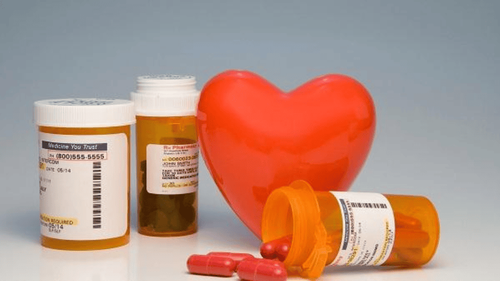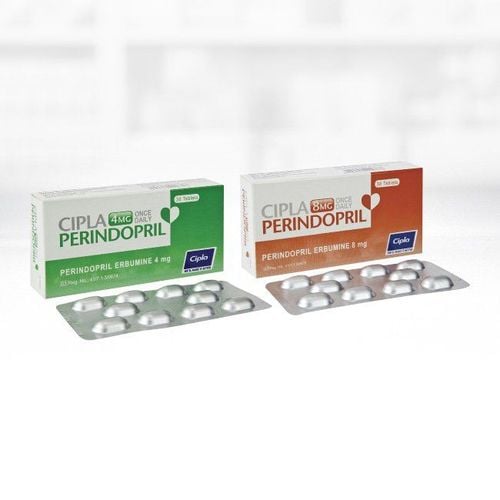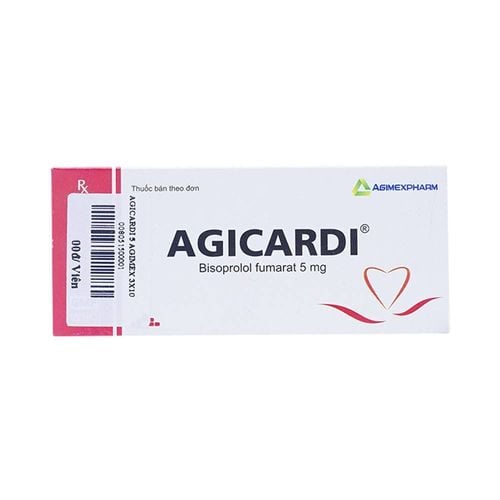This is an automatically translated article.
With the main ingredient is Bisoprolol fumarate, Prolol savi 10 helps to definitively treat cardiovascular conditions such as angina, hypertension, ... to help patients improve in daily activities. So what is Prolol savi 10 drug? What are the uses of Prolol savi 10? The following article will help you better understand the uses of Prolol savi 10.
1. What are the uses of Prolol savi 10?
1.1. What is Prolol savi 10? Prolol savi 10 belongs to the group of cardiovascular drugs, with registration number VD-13870-11, manufactured by Savi Pharm Pharmaceutical Joint Stock Company - Vietnam.
Prolol savi 10 drug with main ingredient is Bisoprolol fumarate (2:1) with 10mg content, prepared in the form of film-coated tablets of 10 tablets, 3 blisters a box.
The drug is recommended for use by adults.
1.2. What are the uses of Prolol savi 10? Bisoprolol acts selectively on the heart, blocking the sympathetic nervous system helps to reduce the heart rate should be used in the treatment of tachyarrhythmias. Bisoprolol also reduces myocardial contractility and causes hypotension. By reducing heart rate and myocardial contractility, beta-blockers reduce the heart's need for oxygen, helping to address the cause of angina.
Prolol savi 10 is prescribed by a doctor in the following cases:
Mild to moderate hypertension. May be used as monotherapy or in combination with other antihypertensive agents, especially diuretics. Chest pain. Support in the treatment of stable chronic heart failure.
2. Usage of Prolol savi 10 blood pressure medicine
2.1. How to take Prolol savi 10 Oral medication
2.2. Dosage of the drug Prolol savi 10 Treatment of hypertension and chronic stable angina:
The usual first dose: 2.5 - 5 mg, once a day; Patients with bronchospasm should start treatment with 2.5 mg once daily. The tolerated dose may be gradually increased to a maximum of 20 mg once daily.
Treatment of stable chronic heart failure:
+ The treatment must be under the supervision of a cardiologist. Before treatment with bisoprolol, patients with chronic heart failure without acute exacerbations within 6 weeks and must be stabilized, Then start adding bisoprolol to the treatment regimen with the principle of starting at the same low dose and increase slowly, follow these steps:
+ Step 1: 1.25 mg/time/day (taken in the morning for 2 weeks. If tolerated, move to step
+ Step 2: 2.5 mg/ times/day for 2 weeks, if well tolerated, move to step 3
+ Step 3: 5 mg/time/day for the next 4 weeks, if well tolerated, move to step 4. + Step 4: 7.5 mg/time/day for the following 4 weeks, if well tolerated, proceed to step 5.
+ Step 5: 10 mg/time/day for maintenance therapy After starting the first dose of 1.25 mg, Patients are monitored for 4 hours (especially blood pressure, heart rate, conduction disturbances, signs of worsening heart failure)
+ Maximum recommended dose: 10mg/time/day.
Treatment of stable chronic heart failure with bisoprolol is a long-term, not abrupt, treatment that can lead to heart failure. hush up. If discontinuation is necessary, the dose should be reduced gradually, in half weekly.
Liver or kidney failure:
+ Patients with kidney damage (Cler < 40ml/min) or liver damage should start at 2.5 mg/time/day; Care should be taken to increase the dose in these patients.
+ Patients with Cler < 20ml/min, angina attacks and hypertension with severe liver damage should not take more than 10 mg/time/day.
Elderly: No dose adjustment is required.
2.3. Treatment of missed dose and overdose when taking Prolol savi 10 Take the dose as soon as you remember, if it is almost time for the next dose, skip the missed dose and take the next dose only. Do not take a double dose.
Signs of dosing effects include bradycardia, hypotension, and lethargy and worsening, delirium, coma, convulsions and respiratory arrest, congestive heart failure, bronchospasm, and hypoglycaemia. may occur, especially in people with pre-existing disease in these organs.
In case of overdose, the patient should immediately see a doctor or the nearest medical facility.
3. Contraindications of Prolol savi 10
Patients who are allergic to the main active ingredient Bisoprolol fumarate Patients with cardiogenic shock, acute heart failure, heart failure not controlled by background therapy, grade III or IV heart failure with inotropic function low left ventricle (ET < 30%), second- or third-degree atrioventricular block and sinus bradycardia (less than 60 ml/min before treatment), sinus node disease. Severe asthma or chronic obstructive pulmonary disease. Severe Reynaud's syndrome. Adrenal medulloblastoma (chromodermal celluloma) when untreated. Low blood pressure (<100 mmHg). Transformation. Hypersensitivity to bisoprolol or to any of the excipients.
4. Side effects of the drug Prolol savi 10
Very common:
Cardiovascular: Bradycardia .
Common:
Cardiovascular: Heart failure. Nervous system: Dizziness, headache. Gastrointestinal: Nausea, vomiting, diarrhea, constipation. Blood vessels: Cold or bad feeling in the extremities, low blood pressure, General: Weakness, fatigue. Uncommon:
Cardiovascular: Atrioventricular conduction disturbances. Musculoskeletal: Muscle weakness, cramps. Psychiatric: Sleep disturbance, depression. Respiratory: Bronchospasm in patients with bronchial asthma or a history of respiratory disease. Rare:
Neurological: the patient may faint. Vision: Decreased lacrimation (must be considered if patient uses contact lenses). Hearing: Mild to moderate hearing disturbance. Respiratory: Allergic rhinitis. Skin and subcutaneous tissues: Hypersensitivity reactions to the skin such as itching, rash, flushing. Liver: inflammation of the liver. Reproductive: has reproductive dysfunction. Psychiatric: Frequent nightmares, hallucinations. Very rare:
Vision: Conjunctivitis. Skin and subcutaneous tissues: Beta-blockers can cause or worsen psoriasis or cause psoriatic rashes, hair loss. Laboratory abnormalities:
There is usually an increase in serum triglycerides but is unlikely to be caused by the drug. There was a slight increase in uric acid, creatinine, BUN, serum potassium, glucose and phosphorus, and a slight decrease in white blood cells and platelets. These changes are not clinically important and rarely require discontinuation of Bisoprolol fumarate.
5. Note when taking Prolol savi 10
Should not be combined with other beta-blockers. Concomitant treatment of Bisoprolol with catecholamine-depleting drugs (reserpine, alpha-methyldopa, clonidine and guanethidine) may result in a significant decrease in heart rate. In patients treated concomitantly with clonidine, if discontinuation of the drug is desired, it is recommended that Bisoprolol be discontinued for several days prior to discontinuation of clonidine. Concomitant use of Bisoprolol with drugs that relax the myocardium or inhibit atrioventricular conduction such as certain calcium antagonists (especially the phenylalkylamine group [verapamil] and the benzothiazepine group [diltiazem]), or antiarrhythmic agents (disopyramide). ) may occur hypotension, bradycardia, arrhythmia or heart failure. Concomitant administration of reserpine, alpha-methyldopa, guanfacine, clonidine or other glycosides may result in a significant decrease in heart rate. Rifampicin increases the metabolism and elimination of Bisoprolol fumarate thereby shortening the half-life of the drug. However, no dose adjustment of Bisoprolol is necessary. Using Bisoprolol at the same time as insulin and oral hypoglycemic agents, may increase the likelihood of their effects. Symptoms of hypoglycemia (especially tachycardia) are masked or mitigated. Blood sugar levels must be monitored regularly.
Please dial HOTLINE for more information or register for an appointment HERE. Download MyVinmec app to make appointments faster and to manage your bookings easily.













